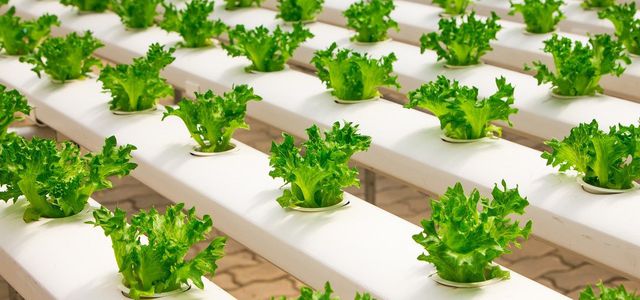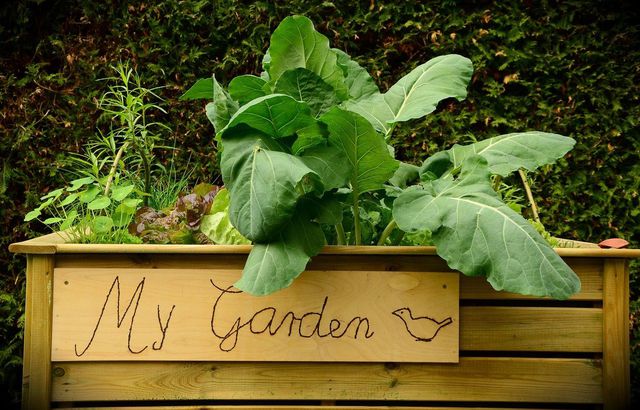Grow plants only in water without soil? That’s exactly how the principle of hydroponics works. And you can even use it on your windowsill.

What is hydroponics?
The term hydroponics comes from the inventor of the concept, Dr. Wilhelm Gericke, and refers to the science of soilless gardening. The word part “hydro” comes from the Greek and translates to water. This is because in hydroponics the soil is, in a sense, replaced by water.
As in “normal cultivation”, a plant in hydroponics is supplied with light, the right temperature, water and nutrients. It gets the light from daylight – only it does not absorb liquid and nutrients via the intermediate medium of soil, but directly from the water.
Contents
- 1 Hydroponics versus normal vegetable cultivation – the advantages and disadvantages
- 2 You can get everything you need from the hardware store:
- 3 And this is how you proceed step by step:
- 4 More options: active and passive hydroponic systems
- 5 The differences between hydroponics, hydroponics and aquaponics
- 6 Author
Hydroponics versus normal vegetable cultivation – the advantages and disadvantages

Proponents of hydroponics find many good arguments for its use:
- You can use hydroponics in a small space.
- You can optimally promote the growth of the plant by controlling the light, temperature, water and nutrient supply.
- With hydroponics, you can grow vegetables all year round.
- In a hydroponic system, the roots should not rot – unlike in soil.
- You don’t have to water the plants daily, and you need to replenish the nutrient solution much less frequently.
- With a little creativity, you can also upcycle a hydroponic system from plastic waste.
- You don’t have to weed.
However, there are drawbacks:
- Some hydroponic systems only work with electricity.
- Most hydroponic systems are made of plastic.
- Also, you need fertilizer for the nutrient solution. If you don’t want to use chemical fertilizer, you can make a nutrient solution from kitchen scraps or tea bags. Instructions can be found on the Home Garden page.
- Depending on the type of construction, you will probably need to get additional materials such as pumps or plastic containers for the water reservoir.
How to build your own hydroponic system.
A hydroponic system doesn’t take up much space – it even fits on a windowsill. You can also grow plants on your balcony with hydroponics. If you’re unsure of how best to get started, you can start with a ready-made hydroponics kit. If you’re creative, somewhat handy, and like to play around, you can also build a simple hydroponic system like Deep Water Culture yourself.
You can get everything you need from the hardware store:
- a plastic box with a lid as a water reservoir
- net pots
- an aquarium pump with aeration stone
- possibly a plant substrate (e.g. pumice stone)
- hydroponic fertilizer
And this is how you proceed step by step:
- Drill holes in the lid of the plastic box where you can insert the net pots.
- Put the aeration stone of the pump into the plastic box.
- If you are using seedlings, carefully wash the soil from the roots before inserting them.
- Place the prepared plants in the net pots and then place the net pots in the plastic box.
- Fill the water into the plastic box so that the net pots hang about one centimeter deep in the water.
- Add fertilizer solution according to package directions. If you are using homemade fertilizer made from leftover tea, you can use it every third time.
- You should aerate your plants every 30 minutes for about 15 minutes. A timer will help with this.
Suitable plants for your hydroponic system include lettuce, spring onions, strawberries, herbs and more. On Hydroponik Urban Gardening you will find more ideas and tips.
More options: active and passive hydroponic systems
The system we have presented is an active system. But there are also passive systems. Here, the plant obtains liquid and nutrients itself via the roots or via capillary effects. In hydroponics, there are three classic, relatively simple passive systems:
Either you work with substrate, for example pumice or coconut fiber. In this case, you plant your plant in the substrate and fill a water reservoir with nutrient solution underneath. In this way, the plant can pull the nutrient solution upwards with the help of the roots and capillary forces.
The wick system works in a similar way. Here, the substrate container and the water reservoir are connected by wicks. These are thin tubes through which the plant draws the nutrient solution.
In a passive system without substrate, you use a net through which your plant can stretch its roots. You place it in a pot over the water reservoir with nutrient solution so that the root ends partially protrude into the water.
Active systems of hydroponics are more complicated in construction. They have elements that need to be powered by electricity, for example pumps or temperature controllers. On the other hand, all plants that bear fruit above ground can theoretically be cultivated in active systems. They include, for example:
Deep Water Culture (described above): Here you let the roots of your plants hang completely in the nutrient solution. An air pump permanently enriches the water with oxygen from below, thus preventing the plants from drowning.
Ebb-and-flow system: The roots are not permanently suspended in the water. Nutrient solution is pumped at regular intervals to the roots, which hang freely or grow on substrate.
Nutrient Film technique: It works similarly to the ebb-and-flow system. The plants are arranged in a row and the tube in which they grow is tilted. A pump is used to pump the nutrient solution into the higher end and then it flows back into the reservoir at the lower end of the tube.
The differences between hydroponics, hydroponics and aquaponics
The distinction between hydroponics and aquaponics is relatively simple: because aquaponics refers to a special system that combines fish farming and vegetable growing. Vegetable growing in aquaponics usually takes place in a hydroponic system. Aquaponics is thus a part of hydroponics.
Hydroponics usually refers to a process in which ornamental plants are grown on expanded clay as a substrate. In hydroponics, on the other hand, the roots usually hang freely and are fully or partially immersed in a nutrient solution.
In this article, you learned how to grow plants without a substrate. If you want to plant plants on expanded clay, you can find information on this in our article on hydroponics.

